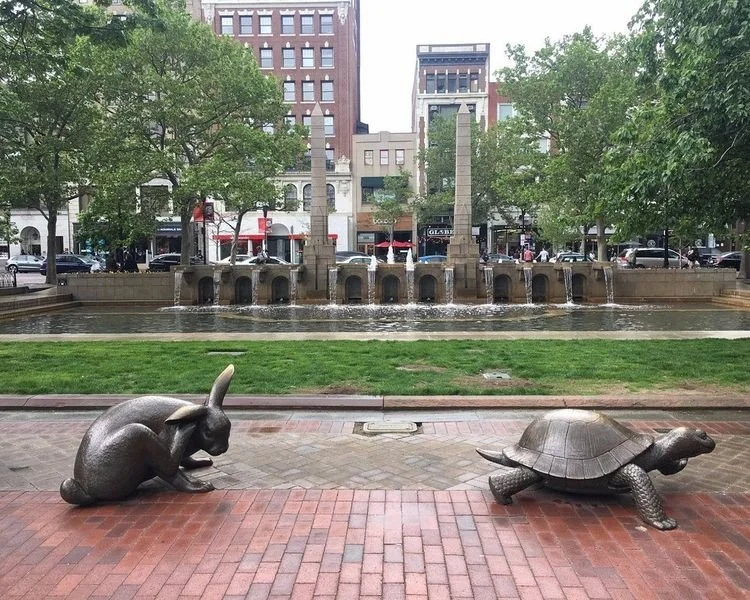The Groove 221 - The Tortoise and The Hare: The Art Market Edition
Welcome to the 221st issue of The Groove.
I am Maria Brito, an art advisor, curator, and author based in New York City.
If you haven’t done so, please subscribe here, to get The Groove in your inbox for free every Tuesday.
THE TORTOISE AND THE HARE: THE ART MARKET EDITION
For the last eight years or so, the art market has rewarded speed over substance. Some artists in their early 30s have found themselves commanding $600,000 or more on the primary market - before they've had time to develop a track record of institutional support or even explore their full artistic potential.
But if that ascent isn’t built on a strong foundation and is driven purely by hype rather than sustained evolution and depth, their careers can burn out just as quickly. The market moves on, and what was once a must-have name fades into obscurity.
My clients and I aren't just looking for market phenomena. We absolutely support young artists, but not just because they're having a moment. Price point, originality, concept, and technical prowess all matter. We want artists who aren't just sprinting but have the depth and endurance to go the distance.
Slow and Steady
The Tortoise and the Hare, 1994, bronze sculpture by Nancy Schön, installed in Boston's Copley Square.
Last week, I recommended an artist who is in his 50s to a young client. His career is a masterclass in steady growth: solo exhibitions in some of the best U.S. museums, acquisitions by top institutions and collectors around the world, and a body of work that continues to evolve. Yet, he hasn't been an auction darling. Does that diminish his impact? Not at all. If anything, it reinforces the strength and endurance of his practice.
All of this reminds me of Aesop’s fable, The Tortoise and the Hare. The market loves the hares: they are fast, flashy, full of energy. But the artists who last are often the tortoises. They build strong foundations, develop their ideas, and don’t burn out from the pressure of unsustainable market expectations or competition with their peers.
The Artists We Forgot
I have written about the re-evaluation of overlooked artists a few times. Given that the binge with young artists during the last decade has left some collectors with a hangover that wasn’t worth the party, many galleries are gravitating toward something else: rediscovering overlooked artists of the past. Historical artists, especially those who had long and strong careers in their time but couldn’t keep the momentum, or died without a proper plan for their legacies, provide a full arc. Collectors and curators can assess an entire body of work, understand its progression, and see how it fits into art history.
This Financial Times article published last week quotes dealer Emmanuel Di Donna, who said it well: “A contemporary artist could do something cool, fun, and expensive now, but you have no idea what they could do in 20 years’ time.” The advantage of historical artists is that their story is complete; there's no risk that they’ll pivot, stagnate, or become repetitive just to satisfy the market.
Some see this shift as taking away opportunities from younger artists. But that’s not quite right. I have clients who simply won’t buy a dead artist, while I have some that have everything from Impressionists to emerging works.
The reality is that the rediscovery trend operates at a different level. These artists tend to be in museum-level conversations, not in competition with emerging artists for primary-market gallery sales. Their price points are often steadier and usually much lower than those of the shooting stars, making them appealing for a different type of collector who want substance over speculation. Plus, curators can put together shows with historical works far more easily than commissioning new pieces or dealing with living artists’ availability and market pressures.
Meanwhile, the frothy, high-risk “wet paint” market, where works sold at auction within three years of creation, has all but collapsed. According to the Financial Times, this sector was worth $215 million at its peak in 2021. By the first half of 2024? Just $30 million. The speculative buying frenzy is over, leaving many collectors holding overhyped works with little lasting cultural value.
Finding the Balance
None of this means young artists aren’t worth investing in. They absolutely are. But the shift we’re seeing in the market is about sustainability. Collectors are becoming more discerning, looking for artists with substance, not just momentum.
The best collections, and I dare to say, the best advisors, understand that art history isn’t just about what’s hot now, but about what will stand the test of time.
While looking at a hare can be exhilarating in the beginning, tortoises are the ones graciously getting to the finish line in one piece.
So whether it’s the artists building slow, steady careers, or those being rediscovered after decades of neglect, one thing is clear: the market is moving away from the sprint and back to the marathon. And that’s a good thing.

